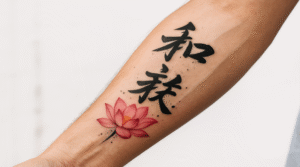Spiritual awakening is a profound journey of self-discovery and enlightenment that many seek to understand and express. Throughout history, art has served as a powerful medium for conveying complex spiritual ideas and personal revelations. Ink, in particular, has been utilized by artists and spiritual practitioners alike to capture the essence of awakening and inner transformation.
Using symbols in ink offers a timeless way to communicate messages that transcend language barriers. These visual representations often carry deep meanings, inspiring seekers to reflect on their own paths and beliefs. Exploring these symbolic expressions reveals the universal nature of spiritual growth and the enduring importance of artistic expression.
The Lotus Flower: Purity and Rebirth
The lotus flower is a universal symbol of spiritual awakening, representing purity and rebirth. Its ability to rise from muddy waters without becoming sullied makes it a powerful metaphor for overcoming challenges on the spiritual path. Artists often depict the lotus in ink illustrations to highlight the journey from ignorance to enlightenment.
In many cultures, the blooming lotus signifies divine purity and the awakening of higher consciousness. When inked as a symbol, it encourages viewers to embrace their own process of growth and self-realization. The intricate detailing required to portray the lotus in ink echoes the delicate yet resilient nature of spiritual awakening.
Furthermore, in spiritual teachings, the lotus is associated with the awakening of the chakras and the realization of one’s true self. Its layered petals symbolize the unfolding of inner wisdom that emerges through perseverance and intent. The monochromatic quality of ink art amplifies the purity and depth of this transformation.
The Mandala: Unity and Wholeness
The intricate design of a mandala serves as a visual representation of unity and spiritual wholeness. Originating from Eastern traditions, mandalas are often created as meditative tools to facilitate inner peace and connection with the divine. Ink drawings of mandalas are revered for their detailed symmetry and symbolic richness.
Artists use ink to craft complex mandalas that reflect the universe and the interconnectedness of all things. The process of designing and coloring these symbolic patterns helps practitioners deepen their meditation and focus their intent. It becomes a journey of discovering the divine order within oneself and the cosmos.
Mandalas’ circular form signifies eternity and the cyclical nature of life and rebirth. When expressed in ink, the stark contrast underscores the tension between the chaos and harmony present in spiritual life. Creating or contemplating mandalas in ink encourages a sense of balance and harmony essential for awakening.
The Om Symbol: Sound and Vibrations
The Om symbol is one of the most sacred sounds in spiritual traditions like Hinduism and Buddhism. It embodies the primordial vibration from which the universe emerges, symbolizing ultimate reality and consciousness. Artists often inscribe the Om symbol in ink to channel its powerful spiritual energy.
Describing this symbol through ink art emphasizes its significance as a meditative focus point. The simple yet profound strokes echo the sounds’ vibration, inviting viewers to connect with a higher state of awareness. It often acts as a visual reminder of the power of mantras in spiritual practice.
In spiritual awakening, Om represents the unity of body, mind, and spirit. When rendered in ink, it can serve as a focal point for meditation or ritual, helping practitioners align with the universe’s vibrations. Its timeless nature makes it a universal symbol guiding seekers toward inner realization.
The Tree of Life: Growth and Interconnection
The Tree of Life is a potent symbol of growth, interconnectedness, and immortality. Its branches, roots, and leaves depict the cycle of life and the importance of balance in spiritual development. Ink illustrations of the Tree of Life highlight the complex web of relationships that define existence.
Artists often utilize ink to portray its intricate branches and roots, emphasizing the delicate yet resilient nature of spiritual growth. The stark contrast of light and dark ink enhances the symbolism of life’s challenges and triumphs. It serves as a reminder that enlightenment involves nurturing both the inner and outer aspects of oneself.
In many spiritual traditions, the Tree of Life stands for immortality and eternal life. It encourages individuals to recognize their connection to wider cosmic forces and to seek harmony within. When expressed in ink, this symbol becomes a visual meditation on life’s perennial cycle and the enduring journey toward awakening.
The Yin-Yang Symbol: Balance and Harmony
The Yin-Yang symbol embodies duality, balance, and harmony governing the universe. Its swirling design represents the interconnected nature of opposing forces, such as light and darkness or male and female. Ink art captures the fluid, dynamic essence of this ancient concept.
Depicting Yin-Yang in ink allows artists to explore its visual flow and contrast effectively. These drawings serve as a reminder that spiritual awakening involves accepting and integrating contrasting elements of existence. The monochromatic technique emphasizes the harmony found in opposition.
Embracing this symbol within spiritual practice encourages seekers to cultivate balance in their lives, understanding that growth arises from the coexistence of different energies. In ink form, the symbol can inspire reflection on stability amid life’s constant changes and uncertainties.
The Phoenix: Rebirth and Transformation
The phoenix, a legendary bird reborn from its ashes, symbolizes rebirth, renewal, and transformative power. Many spiritual traditions incorporate the phoenix as a beacon of hope during times of personal and spiritual crisis. Ink illustrations often depict its majestic form rising anew.
Creating a phoenix in ink emphasizes the resilience and strength required for spiritual transformation. The dynamic lines capture the bird’s soaring ascent and fiery energy, illustrating the process of overcoming despair. It encourages practitioners to embrace change as a path to higher consciousness.
The phoenix’s cycle of death and rebirth highlights the continuous nature of spiritual awakening. Rendered in ink, the powerful imagery serves as a visual affirmation that growth often emerges from destruction and hardship. It inspires hope and perseverance on the journey toward enlightenment.
The Sacred Snake: Transformation and Wisdom
The serpent, or snake, is a potent symbol representing transformation, wisdom, and divine energy. In many spiritual traditions, the snake symbolizes spiritual awakening, shedding of old shells, and gaining new awareness. Ink art frequently depicts snakes coiled or ascending to evoke these themes.
Using ink to illustrate the snake enhances its mystical qualities through stark contrasts and flowing lines. The sinuous form conveys motion and the continuous cycle of renewal. It invites viewers to reflect on the importance of shedding limitations and embracing wisdom.
In spiritual awakening, the snake is often associated with kundalini energy rising through chakras, leading to enlightenment. An ink rendering underscores the dynamic and transformative nature of this energy, encouraging practitioners to harness their inner power and evolve spiritually.
Symbols expressed through ink art serve as timeless vessels for conveying the depths of spiritual awakening. Their powerful imagery inspires introspection, growth, and a deeper understanding of oneself and the universe. These visual representations transcend language, resonating universally across cultures and traditions.
Engaging with these inked symbols allows seekers to connect with profound spiritual truths and motivate their journey toward higher consciousness. Through the delicate strokes and stark contrasts, they embody the delicate balance and vibrant energy inherent in the process of awakening, guiding others along their own paths.







